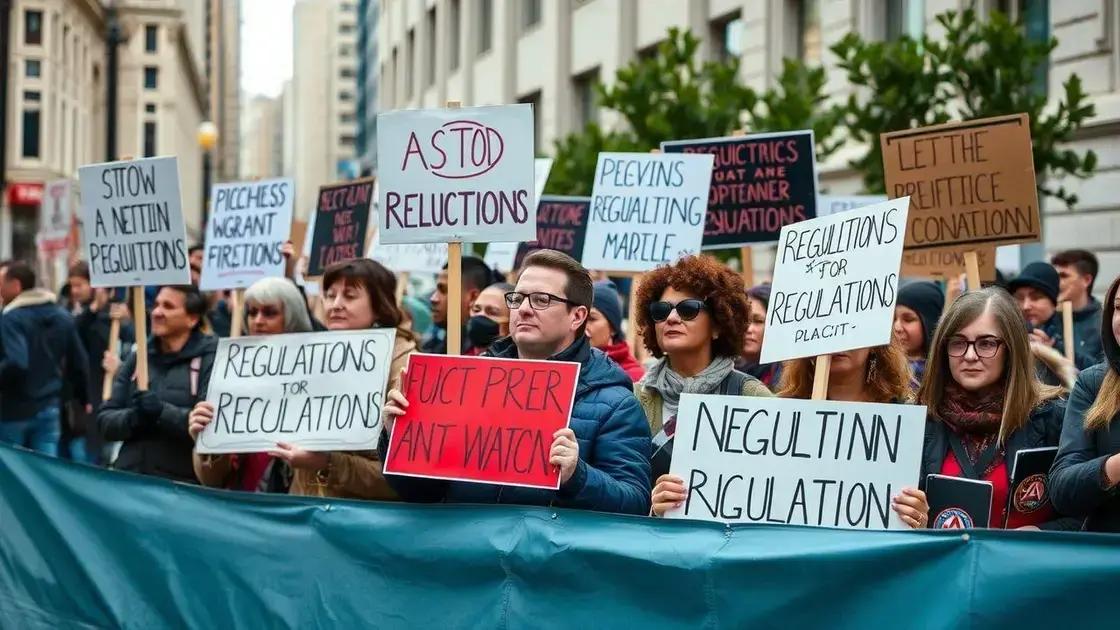Protesters rally in opposition to Trump-era regulations

Protesters rally in opposition to Trump-era regulations, highlighting key issues such as environmental protection, healthcare access, and social justice, while historical context informs current activism and future regulatory changes.
Protesters rally in opposition to Trump-era regulations, standing united to voice their concerns over policies that affect their daily lives. Have you wondered how such regulations could shape the future?
Understanding the Trump-era regulations
Understanding the Trump-era regulations is crucial for grasping the political climate of recent years. These regulations cover a wide range of issues and have sparked significant public debate.
Key Aspects of the Regulations
The regulations implemented during the Trump administration focused on various sectors, from environmental policies to healthcare reforms. These changes were often controversial and led to widespread protests.
- Environmental deregulation and its effects
- Healthcare policy changes and public response
- Impact on immigrant policies
- Economic regulations and their future implications
Moreover, understanding the background behind these regulations helps uncover why they were put in place. Supporters argue that these changes promote business growth and reduce government overreach. However, critics highlight that they can lead to negative consequences for public health and the environment.
Public Reaction to Regulations
The public reaction to these regulations has been mixed, with many people feeling strongly on both sides. Some argue that the deregulation efforts are necessary for economic recovery, while others see them as detrimental to social equity and safety.
Notably, many protests have emerged in response to these regulations. Demonstrators often express their concerns through rallies, social media campaigns, and community meetings. This activism showcases the significant engagement of citizens in political processes, emphasizing how people’s lives are impacted by government actions.
In summary, understanding the Trump-era regulations requires an awareness of their diverse implications and the public’s reaction to them. These regulations are not just policies; they reflect broader societal values and priorities.
Key issues raised by protesters
The key issues raised by protesters against Trump-era regulations reflect deep concerns that many citizens share. These issues often center around personal rights, environmental protection, and social justice.
Major Concerns Addressed
One major topic of protest is the impact of deregulation on the environment. Many activists argue that the rollback of environmental protections threatens public health and wildlife. This concern has led to widespread demonstrations, with citizens demanding stronger action on climate change.
- Environmental degradation and pollution
- Impacts on public health standards
- Consequences for future generations
- Lack of accountability for corporations
Another critical issue raised is the changes to healthcare policies. Protesters express fears that changes in regulations could reduce access to necessary services, especially for vulnerable populations. This has ignited conversations about the importance of universal healthcare and the right to medical treatment.
Social Justice and Equality
Social justice is also at the forefront of many protests. Many believe that changes in regulations exacerbate inequalities, particularly for marginalized communities. Issues related to immigration, racial justice, and economic disparity have mobilized numerous groups in opposition.
Moreover, the protests often emphasize the significance of engaging in civic activities. People are encouraged to voice their opinions, participate in rallies, and vote to ensure their concerns are addressed. This activism helps cultivate a sense of empowerment among communities, reinforcing the idea that public voices matter in shaping policy.
Impact of regulations on communities

The impact of regulations on communities can be profound and widespread. These regulations influence various aspects of daily life, from environmental quality to access to healthcare.
Economic Effects
One major area affected is the economy. Regulations can either enhance economic growth or stifle it, depending on their nature. For example, stricter environmental regulations might entail higher costs for businesses, leading to reduced job opportunities in some sectors.
- Influence on local businesses and industries
- Job creation or loss
- Investment in sustainability vs. immediate profit
- Effects on housing markets
Moreover, compliance with regulations often requires financial resources that smaller businesses may lack. These challenges can lead to a competitive disadvantage, shifting market dynamics within local economies.
Social and Health Implications
The effects on social welfare and public health are equally critical. Regulations that aim to improve workplace safety or environmental standards can significantly enhance community well-being. However, when regulations are rolled back, it may lead to increased health risks.
For instance, changes in regulations regarding air quality can have direct impacts on respiratory health for community members. Many studies illustrate how communities situated near industrial areas suffer from higher rates of health issues due to lax regulations.
Furthermore, the perception of safety within a community can be affected. Residents may feel more secure knowing there are strong regulations protecting their health and environment. This sense of security fosters a vibrant community life, encouraging people to engage and invest in their neighborhoods.
Historical context of protests
The historical context of protests against regulations in the United States is rich and complex. Understanding this history reveals how past movements shape current actions and attitudes towards governance and policy.
Roots of Protest Movements
Protests have long been a part of American history, with roots that can be traced back to the founding of the nation. The Boston Tea Party in 1773 is one of the earliest examples of collective action against government decisions. This event highlighted how citizens could advocate for their rights and push back against policies they deemed unfair.
- Labor movements in the late 1800s demanding fair wages
- The Civil Rights Movement fighting for equality
- Environmental protests in the 1960s and 1970s
- Recent movements focusing on social justice and climate action
Each of these movements reflects a strong desire for change and highlights the power of collective voices. The ability to gather and protest plays a crucial role in shaping policy and holding leaders accountable.
Recent Trends in Protests
In recent years, the emergence of social media has transformed how protests are organized and communicated. People now have the ability to connect instantly, mobilizing support across vast distances. Hashtags and online campaigns have made it easier to raise awareness about specific issues related to regulations.
Recent protests against Trump-era regulations have echoed the themes from past movements. Activists draw on history to emphasize the importance of protecting rights, communities, and the environment. This connection to past struggles empowers current actions while also reminding participants of their potential impact.
Thus, the historical context of protests not only informs current movements but also inspires a sense of duty among citizens to engage with their government. Understanding this lineage encourages people to participate in democracy actively and advocate for the changes they wish to see.
Looking ahead: What comes next?
Looking ahead, the question of what comes next in the realm of regulations and community responses is pivotal. As citizens continue to engage with political decisions, understanding future trends becomes essential.
Anticipated Changes in Regulations
Experts predict several shifts in regulations that may arise in the near future. These changes could be influenced by ongoing environmental concerns, evolving social justice movements, and the economic landscape.
- Increased focus on climate change policies
- Expansion of healthcare access and affordability
- Stricter regulations on corporate accountability
- Policies aimed at promoting equity and inclusion
Each of these expected changes reflects the ongoing dialogue within society about balancing growth with responsibility.
Role of Activism in Future Policies
Activism will undoubtedly play a key role in shaping the future of regulations. Grassroots movements are becoming increasingly organized and vocal. Social media allows activists to share information quickly and rally support. This engagement can lead to rapid shifts in public opinion, influencing lawmakers to act.
Moreover, continued protests highlight the importance of civic participation. As people express their views through various platforms, they help steer political conversations. This dynamic opens doors for new ideas and policies that reflect the needs of diverse communities.
Ultimately, the direction of future regulations will depend heavily on the collective voice of the people. Engaging in discussions and advocating for change will crucially influence what policies are adopted going forward. Keeping informed and involved can empower communities to actively shape their governance and environment.
FAQ – Questions about Protests and Regulations
What are some common issues that protesters raise against regulations?
Protesters often raise concerns about environmental degradation, healthcare access, and social justice, highlighting how regulations impact their lives.
How do historical protests influence current movements?
Historical protests provide context and inspiration, helping current activists understand effective strategies for advocating change.
What role does activism play in shaping future regulations?
Activism brings attention to important issues, encouraging lawmakers to consider public opinion and adjust policies accordingly.
How can community members get involved in advocacy?
Community members can participate in protests, engage in discussions, and vote, helping to amplify their voices and influence policy decisions.






